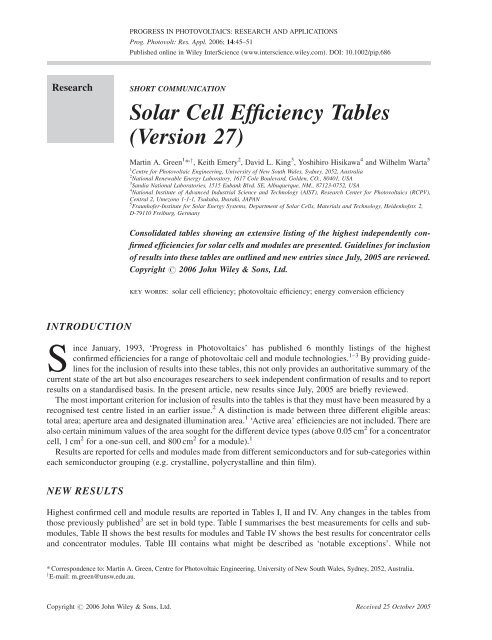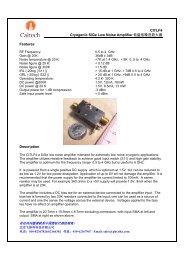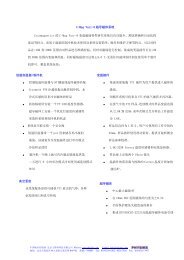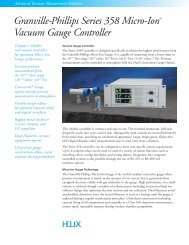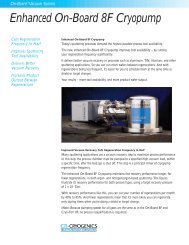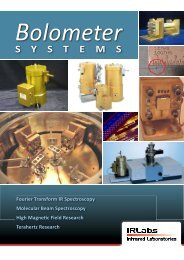Solar cell efficiency tables (version 27) - ResearchGate
Solar cell efficiency tables (version 27) - ResearchGate
Solar cell efficiency tables (version 27) - ResearchGate
Create successful ePaper yourself
Turn your PDF publications into a flip-book with our unique Google optimized e-Paper software.
PROGRESS IN PHOTOVOLTAICS: RESEARCH AND APPLICATIONS<br />
Prog. Photovolt: Res. Appl. 2006; 14:45–51<br />
Published online in Wiley InterScience (www.interscience.wiley.com). DOI: 10.1002/pip.686<br />
Research<br />
SHORT COMMUNICATION<br />
<strong>Solar</strong> Cell Efficiency Tables<br />
(Version <strong>27</strong>)<br />
Martin A. Green 1 * ,y , Keith Emery 2 , David L. King 3 , Yoshihiro Hisikawa 4 and Wilhelm Warta 5<br />
1 Centre for Photovoltaic Engineering, University of New South Wales, Sydney, 2052, Australia<br />
2 National Renewable Energy Laboratory, 1617 Cole Boulevard, Golden, CO., 80401, USA<br />
3 Sandia National Laboratories, 1515 Eubank Blvd. SE, Albuquerque, NM., 87123-0752, USA<br />
4 National Institute of Advanced Industrial Science and Technology (AIST), Research Center for Photovoltaics (RCPV),<br />
Central 2, Umezono 1-1-1, Tsukuba, Ibaraki, JAPAN<br />
5 Fraunhofer-Institute for <strong>Solar</strong> Energy Systems, Department of <strong>Solar</strong> Cells, Materials and Technology, Heidenhofstr. 2,<br />
D-79110 Freiburg, Germany<br />
Consolidated <strong>tables</strong> showing an extensive listing of the highest independently confirmed<br />
efficiencies for solar <strong>cell</strong>s and modules are presented. Guidelines for inclusion<br />
of results into these <strong>tables</strong> are outlined and new entries since July, 2005 are reviewed.<br />
Copyright # 2006 John Wiley & Sons, Ltd.<br />
key words: solar <strong>cell</strong> <strong>efficiency</strong>; photovoltaic <strong>efficiency</strong>; energy con<strong>version</strong> <strong>efficiency</strong><br />
INTRODUCTION<br />
Since January, 1993, ‘Progress in Photovoltaics’ has published 6 monthly listings of the highest<br />
confirmed efficiencies for a range of photovoltaic <strong>cell</strong> and module technologies. 1–3 By providing guidelines<br />
for the inclusion of results into these <strong>tables</strong>, this not only provides an authoritative summary of the<br />
current state of the art but also encourages researchers to seek independent confirmation of results and to report<br />
results on a standardised basis. In the present article, new results since July, 2005 are briefly reviewed.<br />
The most important criterion for inclusion of results into the <strong>tables</strong> is that they must have been measured by a<br />
recognised test centre listed in an earlier issue. 2 A distinction is made between three different eligible areas:<br />
total area; aperture area and designated illumination area. 1 ‘Active area’ efficiencies are not included. There are<br />
also certain minimum values of the area sought for the different device types (above 0.05 cm 2 for a concentrator<br />
<strong>cell</strong>, 1 cm 2 for a one-sun <strong>cell</strong>, and 800 cm 2 for a module). 1<br />
Results are reported for <strong>cell</strong>s and modules made from different semiconductors and for sub-categories within<br />
each semiconductor grouping (e.g. crystalline, polycrystalline and thin film).<br />
NEW RESULTS<br />
Highest confirmed <strong>cell</strong> and module results are reported in Tables I, II and IV. Any changes in the <strong>tables</strong> from<br />
those previously published 3 are set in bold type. Table I summarises the best measurements for <strong>cell</strong>s and submodules,<br />
Table II shows the best results for modules and Table IV shows the best results for concentrator <strong>cell</strong>s<br />
and concentrator modules. Table III contains what might be described as ‘notable exceptions’. While not<br />
* Correspondence to: Martin A. Green, Centre for Photovoltaic Engineering, University of New South Wales, Sydney, 2052, Australia.<br />
y E-mail: m.green@unsw.edu.au.<br />
Copyright # 2006 John Wiley & Sons, Ltd. Received 25 October 2005
46 M. A. GREEN ET AL.<br />
Table I. Confirmed terrestrial <strong>cell</strong> and submodule efficiencies measured under the global AM1.5 spectrum (1000 Wm 2 )<br />
at 25 C<br />
Classification a Effic. b Area c V oc J sc FF d Test Centre e Description<br />
(%) (cm 2 ) (V) (mA/cm 2 ) (%) (and Date)<br />
Silicon<br />
Si (crystalline) 24.7 0.5 4.00 (da) 0.706 42.2 82.8 Sandia (3/99) UNSW PERL 9<br />
Si (multicrystalline) 20.3 0.5 1.002 (ap) 0.664 37.7 80.9 NREL (5/04) FhG-ISE 10<br />
Si (thin film transfer) 16.6 0.4 4.017 (ap) 0.645 32.8 78.2 FhG-ISE (7/01) U. Stuttgart (45 mm thick) 11<br />
III–V Cells<br />
GaAs (crystalline) 25.1 0.8 3.91 (t) 1.022 28.2 87.1 NREL (3/90) Kopin, AlGaAs window 12<br />
GaAs (thin film) 24.5 0.5 1.002 (t) 1.029 28.8 82.5 FhG-ISE (5/05) Radboud U., NL 13<br />
GaAs (multicrystalline) 18.2 0.5 4.011 (t) 0.994 23.0 79.7 NREL (11/95) RTI, Ge substrate 14<br />
InP (crystalline) 21.9 0.7 4.02 (t) 0.878 29.3 85.4 NREL (4/90) Spire, epitaxial 15<br />
Thin film chalcogenide<br />
CIGS (<strong>cell</strong>) 18.4 0.5 f 1.04(ap) 0.669 35.7 77.0 NREL (2/01) NREL, CIGS on glass 16<br />
CIGS (submodule) 16.6 0.4 16.0 (ap) 2.643 8.35 75.1 FhG-ISE (3/00) U. Uppsala, 4 serial <strong>cell</strong>s 17<br />
CdTe (<strong>cell</strong>) 16.5 0.5 f 1.032 (ap) 0.845 25.9 75.5 NREL (9/01) NREL, mesa on glass 18<br />
Amorphous/<br />
nanocrystalline Si<br />
Si (amorphous) g 9.5 0.3 1.070 (ap) 0.859 17.5 63.0 NREL (4/03) U. Neuchatel 19<br />
Si (nanocrystalline) 10.1 0.2 1.199 (ap) 0.539 24.4 76.6 JQA (12/97) Kaneka (2 mm on glass) 20<br />
Photochemical<br />
Nanocrystalline dye 10.4 0.3 1.004(ap) 0.729 21.8 65.2 AIST (8/05) Sharp 5<br />
Nanocrystalline dye 4.7 0.2 141.4 (ap) 0.795 11.3 59.2 FhG-ISE (2/98) INAP<br />
(submodule)<br />
Multijunction devices<br />
GaInP/GaAs/Ge 32.0 1.5 3.989(t) 2.622 14.37 85.0 NREL (1/03) Spectrolab (monolithic)<br />
GaInP/GaAs 30.3 4.0 (t) 2.488 14.22 85.6 JQA (4/96) Japan Energy<br />
(monolithic) 21<br />
GaAs/CIS (thin film) 25.8 1.3 4.00 (t) — — — NREL (11/89) Kopin/Boeing (4 terminal)<br />
a-Si/CIGS (thin film) h 14.6 0.7 2.40 (ap) — — — NREL (6/88) ARCO (4 terminal) 22<br />
a-Si/mc-Si (thin submodule) i 11.7 0.4 14.23(ap) 5.462 2.99 71.3 AIST (9/04) Kaneka (thin film) 23<br />
a CIGS ¼ CuInGaSe 2 ; a-Si ¼ amorphous silicon/hydrogen alloy.<br />
b Effic. ¼ <strong>efficiency</strong>.<br />
c (ap) ¼ aperture area; (t) ¼ total area; (da) ¼ designated illumination area.<br />
d FF ¼ fill factor.<br />
e FhG-ISE ¼ Fraunhofer-Insitut für <strong>Solar</strong>e Energiesysteme; JQA ¼ Japan Quality Assurance; AIST ¼ Japanese National Institute of<br />
Advanced Industrial Science and Technology.<br />
f Not measured at an external laboratory.<br />
g Stabilised by 800 h, 1 sun AM1.5 illumination at a <strong>cell</strong> temperature of 50 C.<br />
h Unstabilised results.<br />
i Stabilised by 174 h, 1-sun illumination after 20 h, 5-sun illumination at a sample temperature of 50 C.<br />
conforming to the requirements to be recognised as a class record, the <strong>cell</strong>s and modules in this Table have<br />
notable characteristics that will be of interest to sections of the photovoltaic community with entries based<br />
on their significance and timeliness. In most cases, a literature reference is provided that describes either the<br />
result reported or a similar result.<br />
To ensure discrimination, Table III is limited to 10 entries with the present authors having voted for their<br />
preferences for inclusion. Readers who have suggestions of results for inclusion into this Table are welcome<br />
to contact any of the authors with full details. Suggestions conforming to the guidelines will be included on the<br />
voting list for a future issue. (A smaller number of ‘notable exceptions’ for concentrator <strong>cell</strong>s and modules<br />
additionally is included in Table IV, as are results under a recently proposed low aerosol optical depth<br />
direct-beam spectrum 4 ).<br />
Copyright # 2006 John Wiley & Sons, Ltd. Prog. Photovolt: Res. Appl. 2006; 14:45–51
SOLAR CELL EFFICIENCY TABLES 47<br />
Table II. Confirmed terrestrial module efficiencies measured under the global AM1.5 spectrum (1000 W/m 2 ) at a <strong>cell</strong><br />
temperature of 25 C<br />
Classification a Effic. b Area c V oc I sc FF d Test Centre Description<br />
(%) (cm 2 ) (V) (A) (%) (and Date)<br />
Si (crystalline) 22.7 0.6 778 (da) 5.60 3.93 80.3 Sandia (9/96) UNSW/Gochermann 24<br />
Si (multicrystalline) 15.3 0.4 e 1017 (ap) 14.6 1.36 78.6 Sandia (10/94) Sandia/HEM 25<br />
Si (thin-film polycrystalline) 8.2 0.2 661(ap) 25.0 0.318 68.0 Sandia (7/02) Pacific <strong>Solar</strong> (1–2 mm on glass) 25<br />
CIGSS 13.4 0.7 3459 (ap) 31.2 2.16 68.9 NREL (8/02) Showa Shell (Cd free) <strong>27</strong><br />
CdTe 10.7 0.5 4874 (ap) 26.21 3.205 62.3 NREL (4/00) BP <strong>Solar</strong>ex 28<br />
a-Si/a-SiGe/a-SiGe (tandem) f 10.4 0.5 905 (ap) 4.353 3.285 66.0 NREL (10/98) USSC (a-Si/a-Si/a-Si:Ge) 29<br />
a CIGSS ¼ CuInGaSSe; a-Si ¼ amorphous silicon/hydrogen alloy; a-SiGe ¼ amorphous silicon/germanium/hydrogen alloy.<br />
b Effic. ¼ <strong>efficiency</strong>.<br />
c (ap) ¼ aperture area; (da) ¼ designated illumination area.<br />
d FF ¼ fill factor.<br />
e Not measured at an external laboratory.<br />
f Light soaked at NREL for 1000 h at 50 C, nominally 1-sun illumination.<br />
The first new result is in Table I where an <strong>efficiency</strong> of 10.4% is reported for a 1 cm 2 nanocrystalline dye <strong>cell</strong><br />
fabricated by Sharp and measured at the Japanese National Institute of Advanced Industrial Science and Technology<br />
(AIST).<br />
The second new result is for a large area, commercial-size multicrystalline silicon <strong>cell</strong> and is reported in<br />
Table III as a ‘notable exception’. An <strong>efficiency</strong> of 18.1% has been confirmed by the Fraunhofer Institute<br />
for <strong>Solar</strong> Energy Systems (FhG-ISE) for a large area (137.7 cm 2 ) laser grooved, buried contact <strong>cell</strong> fabricated<br />
by the University of Kontanz, improving substantially on the University’s earlier 17.6% result. 6<br />
Three new concentrator results are reported in Table IV. Record single-junction concentrator <strong>cell</strong><br />
performance of <strong>27</strong>.6% is reported in Table IV for a back contacted <strong>cell</strong> fabricated by Amonix 7 and<br />
measured at the Fraunhofer Institute for <strong>Solar</strong> Energy Systems (FhG-ISE) under a concentrated low aerosol<br />
Table III. ‘Notable exceptions’: ‘Top ten’ confirmed <strong>cell</strong> and module results, not class records (Global AM1.5 spectrum,<br />
1000 Wm 2 ,25 C)<br />
Classification a Effic. b Area c V oc J sc FF Test Centre Description<br />
(%) (cm 2 ) (V) (mA/cm 2 ) (%) (and Date)<br />
Cells (Silicon)<br />
Si (MCZ crystalline) 24.5 0.5 4.0 (da) 0.704 41.6 83.5 Sandia (7/99) UNSW PERL, SEH MCZ<br />
substrate 30<br />
Si (moderate area) 23.7 0.5 22.1(da) 0.704 41.5 81.0 Sandia (8/96) UNSW PERL 24 , FZ substrate<br />
Si (large FZ crystalline) 21.5 0.6 148.9(t) 0.678 39.5 80.3 NREL (9/03) Sunpower FZ substrate 31<br />
Si (large CZ crystalline) 21.5 0.3 100.3(t) 0.712 38.3 78.7 AIST (12/04) Sanyo HIT, n-type CZ substrate 32<br />
Si (large CZ crystalline) 18.3 0.5 147.5(t) 0.625 36.3 80.6 FhG-ISE (9/02) BP <strong>Solar</strong>, laser grooved 33<br />
Si (large multicrystalline) 18.1 0.5 137.7(t) 0.636 36.9 77.0 FhG-ISE (8/05) U. Konstanz, laser grooved 6<br />
Cells (Other)<br />
GaInP/GaInAs/Ge tandem) 31.3 1.5 4.0 (t) 2.392 16.0 81.9 NREL (1/03) Spectrolab, monolithic<br />
metamorphic<br />
CIGS (thin film) 19.5 0.6 0.410(ap) 0.693 35.3 79.4 FhG-ISE (9/04) NREL, CIGS on glass 34<br />
a-Si/a-Si/a-SiGe (tandem) 12.1 0.7 0.<strong>27</strong> (da) 2.297 7.56 69.7 NREL (10/96) USSC stabilised (monolithic) 35<br />
Photoelectrochemical 11.0 0.5 0.25(ap) 0.795 19.4 71.0 FhG-ISE (12/96) EPFL, nanocrystalline dye 36<br />
a CIGS ¼ CuInGaSe 2 .<br />
b Effic. ¼ <strong>efficiency</strong>.<br />
c (ap) ¼ aperture area; (t) ¼ total area; (da) ¼ designated illumination area.<br />
Copyright # 2006 John Wiley & Sons, Ltd. Prog. Photovolt: Res. Appl. 2006; 14:45–51
48 M. A. GREEN ET AL.<br />
Table IV. Terrestrial concentrator <strong>cell</strong> and module efficiencies measured under the direct beam AM1.5 spectrum at a <strong>cell</strong><br />
temperature of 25 C<br />
Classification Effic. a Area b Intensity c Test centre Description<br />
(%) (cm 2 ) (suns) (and Date)<br />
Single <strong>cell</strong>s<br />
GaAs <strong>27</strong>.6 1.0 0.126 (da) 255 Sandia (5/91) Spire 37<br />
GaInAsP <strong>27</strong>.5 1.4 d 0.075 (da) 171 NREL (2/91) NREL, Entech cover<br />
Si 26.8 0.8 1.60 (da) 96 FhG-ISE (10/95) SunPower back-contact 38<br />
InP 24.3 1.2 d 0.075 (da) 99 NREL (2/91) NREL, Entech cover 39<br />
CIGS (thin film) 21.5 1.5 d 0.102 (da) 14 NREL (2/01) NREL<br />
2-<strong>cell</strong> stacks<br />
GaAs/GaSb (4 terminal) 32.6 1.7 0.053 (da) 100 Sandia e (10/89) Boeing, mechanical stack 40<br />
InP/GaInAs (3 terminal) 31.8 1.6 d 0.063 (da) 50 NREL (8/90) NREL, monolithic 41<br />
GaInP/GaInAs (2-terminal) 30.2 1.2 0.1326 (da) 300 NREL/FhG-ISE (6/01) Fraunhofer, monolithic 42<br />
GaInP/GaAs (2 terminal) 30.2 1.4 0.103 (da) 180 Sandia (3/94) NREL, monolithic 43<br />
GaAs/Si (large) (4-terminal) 29.6 1.5 d 0.317 (da) 350 Sandia e (9/88) Varian/Stanford/<br />
Sandia, mech. Stack 44<br />
3-<strong>cell</strong> stacks<br />
GaInP/GaAs/Ge (2-terminal) 34.7 1.7 0.2665(da) 333 NREL (9/03) Spectrolab, monolithic<br />
Submodules<br />
GaInP/GaAs/Ge <strong>27</strong>.0 1.5 34 (ap) 10 NREL (5/00) ENTECH 45<br />
GaAs/GaSb 25.1 1.4 41.4 (ap) 57 Sandia (3/93) Boeing, 3 mech. stack units 46<br />
Modules<br />
Si 20.3 0.8 d 1875 (ap) 80 Sandia (4/89) Sandia/UNSW/<br />
ENTECH (12 <strong>cell</strong>s) 47<br />
Low-AOD spectrum f<br />
GaInP/GaInAs/Ge 39.0 2.3 f 0.2691 (da) 236 NREL (5/05) Spectrolab, low-AOD spectrum 8<br />
(2-terminal)<br />
Si <strong>27</strong>.6 1.0 1.00 (da) 92 FhG-ISE (11/04) Amonix back-contact 7<br />
‘Notable exceptions’<br />
GaInP/GaInAs/Ge 38.8 2.3 f 0.254(da) 241 NREL (5/05) Spectrolab, metamorphic 8<br />
(2-terminal)<br />
Si ( large) 21.6 0.7 20.0 (da) 11 Sandia e (9/90) UNSW laser grooved 48<br />
GaAs (Si substrate) 21.3 0.8 0.126 (da) 237 Sandia (5/91) Spire 37<br />
InP (GaAs substrate) 21.0 1.1 d 0.075 (da) 88 NREL (2/91) NREL, Entech cover 49<br />
a Effic. ¼ <strong>efficiency</strong>.<br />
b (da) ¼ designated illumination area; (ap) ¼ aperture area.<br />
c One sun corresponds to an intensity of 1000 Wm 2 .<br />
d Not measured at an external laboratory.<br />
e Measurements corrected from originally measured values due to Sandia recalibration in January, 1991.<br />
f Low aerosol optical depth direct beam AM1.5 spectrum.<br />
density AM1.5 direct-beam spectrum. 4 Two further improvements are reported for multiple junction <strong>cell</strong>s.<br />
The first is the demonstration of 39% <strong>efficiency</strong> at 236 suns concentration for a 0.<strong>27</strong> cm 2 GaInP/GaInAs/Ge<br />
triple junction <strong>cell</strong> fabricated by Spectrolab 8 and measured at the US National Renewable Energy Laboratory<br />
(NREL), again under the low aerosol density AM1.5 spectrum. Metamorphic <strong>cell</strong>s with the same nominal<br />
structure but with 8% indium in the middle <strong>cell</strong>, producing 0.5% lattice mismatch, gave nearly identical results<br />
with efficiencies up to 38.8% demonstrated under the same spectrum 8 and recorded in Table IV as a ‘notable<br />
exception’.<br />
Finally, Figure 1 shows, for several key <strong>cell</strong> categories, the evolution of the <strong>efficiency</strong> values reported in these<br />
Tables over the 1993–2006 period. The monolithic III–V stacked concentrator <strong>cell</strong>s have shown the largest<br />
gains, with <strong>efficiency</strong> increasing from below 30% to close to 40% over this period. CIGS technology also<br />
showed very rapid progress over the first part of this period, with good recent progress shown for nanocrystalline<br />
dye <strong>cell</strong>s of a qualifying size (at least 1 cm 2 ).<br />
Copyright # 2006 John Wiley & Sons, Ltd. Prog. Photovolt: Res. Appl. 2006; 14:45–51
SOLAR CELL EFFICIENCY TABLES 49<br />
40<br />
35<br />
III-V Stacked<br />
Concentrator<br />
(2 terminal)<br />
III-V Stacked<br />
(2 terminal)<br />
Efficiency, %<br />
30<br />
25<br />
20<br />
15<br />
10<br />
5<br />
Si Concentrator<br />
a-Si or uc-Si<br />
c-Si<br />
mc-Si<br />
CIGS<br />
CdTe<br />
Dye<br />
Sensitised<br />
1990 1995 2000 2005 2010<br />
Figure 1. Evolution of solar <strong>cell</strong> <strong>efficiency</strong> over the 1993–2006 timeframe for several major <strong>cell</strong> categories as reflected by<br />
values reported in these Tables (the apparent decrease for ‘a-Si or mc-Si’ <strong>cell</strong>s is due to a change in reporting from<br />
‘unstabilised’ to ‘stabilised’ results, reflecting commercial practice)<br />
DISCLAIMER<br />
While the information provided in the <strong>tables</strong> is provided in good faith, the authors, editors and publishers cannot<br />
accept direct responsibility for any errors or omissions.<br />
REFERENCES<br />
1. Green MA, Emery K, King DL, Igari S. <strong>Solar</strong> <strong>cell</strong> <strong>efficiency</strong> <strong>tables</strong> (<strong>version</strong> 15). Progress in Photovoltaics: Research<br />
and Applications 2000; 8: 187–196.<br />
2. Green MA, Emery K, King DL, Igari S. <strong>Solar</strong> <strong>cell</strong> <strong>efficiency</strong> <strong>tables</strong> (<strong>version</strong> 17). Progress in Photovoltaics: Research<br />
and Applications 2001; 9: 49–56.<br />
3. Green MA, Emery K, King DL, Igari S, Warta W. <strong>Solar</strong> <strong>cell</strong> <strong>efficiency</strong> <strong>tables</strong> (<strong>version</strong> 26). Progress in Photovoltaics:<br />
Research and Applications 2005; 13: 387–392.<br />
4. Gueymard CA, Myers D, Emery K. Proposed reference irradiance spectra for solar energy systems testing. <strong>Solar</strong> Energy<br />
2002; 73: 443–467.<br />
5. Chiba Y, Islam A, Kakutani K, Komiya R, Koide N, Han L. High <strong>efficiency</strong> dye sensitized solar <strong>cell</strong>s. Technical Digest,<br />
15th International Photovoltaic Science and Engineering Conference, Shanghai, October, 2005; 665–666.<br />
6. Jooss W, McCann M, Fath P, Roberts S, Bruton TM. Buried contact solar <strong>cell</strong>s on multicrystalline silicon with optimised<br />
bulk and surface passivation. Third World Conference on Photovoltaic Energy Con<strong>version</strong> (WCPEC-3), Osaka, May,<br />
2003; 959–962.<br />
7. Slade A, Garboushian V. <strong>27</strong>.6% efficient silicon concentrator <strong>cell</strong> for mass production. Technical Digest, 15th<br />
International Photovoltaic Science and Engineering Conference, Beijing, October, 2005; 701.<br />
8. King RR, Law DC, Fetzer CM, Sherif RA, Edmondson KM, Kurtz S, Kinsey GS, Cotal HL, Krut DD, Ermer JH, Karam<br />
NH. Pathways to 40% efficient concentrator photovoltaics. Conference Proceedings, 20th European Photovoltaic <strong>Solar</strong><br />
Energy Conference, Barcelona, June, 2005; 118–123.<br />
9. Zhao J, Wang A, Green MA, Ferrazza F. Novel 19.8% efficient ‘honeycomb’ textured multicrystalline and 24.4%<br />
monocrystalline silicon solar <strong>cell</strong>s. Applied Physics Letters 1998; 73: 1991–1993.<br />
10. Shultz O, Glunz SW, Goldschmidt JC, Lautenschlager H, Leimenstoll A, Scheiderlochner E, Willeke GP. Thermal<br />
oxidation processes for high-<strong>efficiency</strong> multicrystalline silicon solar <strong>cell</strong>s. 19th European Photovoltaic <strong>Solar</strong> Energy<br />
Conference, Paris, June, 2004.<br />
Copyright # 2006 John Wiley & Sons, Ltd. Prog. Photovolt: Res. Appl. 2006; 14:45–51
50 M. A. GREEN ET AL.<br />
11. Bergmann, RB, Rinke, TJ, Berge, C, Schmidt J, Werner, JH. Advances in monocrystalline Si thin-film solar <strong>cell</strong>s by layer<br />
transfer. Technical Digest, PVSEC-12, June, 2001, Chefju Island, Korea; 11–15.<br />
12. Gale RP, McClelland RW, Dingle DB, Gormley JV, Burgess RM, Kim, NP, Mickelsen RA, Stanbery BF. High-<strong>efficiency</strong><br />
GaAs/CuInSe 2 and AlGaAs/CuInSe 2 thin-film tandem solar <strong>cell</strong>s, Conference Record, 21st IEEE Photovoltaic<br />
Specialists Conference, Kissimimee, May 1990; 53–57.<br />
13. Bauhuis GJ, Mulder P, Schermer JJ, HaverKamp EJ, van Deelen J, Larsen PK. High <strong>efficiency</strong> thin film GaAs solar <strong>cell</strong>s<br />
with improved radiation hardness. 20th European Photovoltaic <strong>Solar</strong> Energy Conference, Barcelona, June, 2005; 468–<br />
471.<br />
14. Venkatasubramanian R, O’Quinn BC, Hills JS, Sharps PR, Timmons ML, Hutchby JA, Field H, Ahrenkiel A, Keyes B.<br />
18.2% (AM1.5) efficient GaAs solar <strong>cell</strong> on optical-grade polycrystalline Ge substrate. Conference Record, 25th IEEE<br />
Photovoltaic Specialists Conference, Washington, May 1997; 31–36.<br />
15. Keavney CJ, Haven VE, Vernon SM. Emitter structures in MOCVD InP solar <strong>cell</strong>s. Conference Record, 21st IEEE<br />
Photovoltaic Specialists Conference, Kissimimee, May, 1990; 141–144.<br />
16. Contreras MA, Egaas B, Ramanathan K, Hiltner J, Swartzlander A, Hasoon F, Noufi R. Progress towards 20% <strong>efficiency</strong><br />
in Cu(In,Ga)Se polycrystalline thin-film solar <strong>cell</strong>. Progress in Photovoltaics: Research and Applications 1999; 7: 311–<br />
316.<br />
17. Kessler J, Bodegard M, Hedstrom J, Stolt L. New world record Cu (In,Ga) Se 2 based mini-module: 16.6%, Proceedings.<br />
16th European Photovoltaic <strong>Solar</strong> Energy Conference, Glasgow, 2000; 2057–2060.<br />
18. Wu X, Keane JC, Dhere RG, DeHart C, Duda A, Gessert TA, Asher S, Levi DH, Sheldon P. 16.5%-efficient CdS/CdTe<br />
polycrystalline thin-film solar <strong>cell</strong>. Conference Proceedings, 17th European Photovoltaic <strong>Solar</strong> Energy Conference,<br />
Munich, 22–26 October 2001; 995–1000.<br />
19. Meier J, Sitznagel J, Kroll U, Bucher C, Fay S, Moriarty T, Shah A. Potential of amorphous and microcrystalline silicon<br />
solar <strong>cell</strong>s. Thin Solid Films 2004; 451–452: 518–524.<br />
20. Yamamoto K, Toshimi M, Suzuki T, Tawada Y, Okamoto T, Nakajima A. Thin film poly-Si solar <strong>cell</strong> on glass substrate<br />
fabricated at low temperature, MRS Spring Meeting, San Francisco April, 1998.<br />
21. Ohmori M, Takamoto T, Ikeda E, Kurita H. High <strong>efficiency</strong> InGaP/GaAs tandem solar <strong>cell</strong>s. Technical Digest,<br />
International PVSEC-9, Miyasaki, Japan, November, 1996; 525–528.<br />
22. Mitchell K, Eberspacher C, Ermer J, Pier D. Single and tandem junction CuInSe 2 <strong>cell</strong> and module technology.<br />
Conference Record, 20th IEEE Photovoltaic Specialists Conference, Las Vegas, September, 1988; 1384–1389.<br />
23. Yoshimi M, Sasaki T, Sawada T, Suezaki T, Meguro T, Matsuda T, Santo K, Wadano K, Ichikawa M, Nakajima A,<br />
Yamamoto K. High <strong>efficiency</strong> thin film silicon hybrid solar <strong>cell</strong> module on Im 2 -class large area substrate. Conference<br />
Record, 3rd World Conference on Photovoltaic Energy Con<strong>version</strong>, Osaka, May, 2003; 1566–1569.<br />
24. Zhao J, Wang A, Yun F, Zhang G, Roche DM, Wenham SR, Green MA. 20,000 PERL silicon <strong>cell</strong>s for the ‘1996 World<br />
<strong>Solar</strong> Challenge’ solar car race, Progress in Photovoltaics 1997; 5: 269–<strong>27</strong>6.<br />
25. King DL, Schubert WK, Hund TD. World’s first 15% <strong>efficiency</strong> multicrystalline silicon modules. Conference Record,<br />
1st World Conference on Photovoltaic Energy Con<strong>version</strong>, Hawaii, December, 1994; 1660–1662.<br />
26. Basore PA. Pilot production of thin-film crystalline silicon on glass modules, Conference Record, 29th IEEE<br />
Photovoltaic Specialists Conference, New Orleans, May, 2002; 49–52.<br />
<strong>27</strong>. Tanaka Y, Akema N, Morishita T, Okumura D, Kushiya K. Improvement of V oc upward of 600 mV/<strong>cell</strong> with CIGS-based<br />
absorber prepared by Selenization/Sulfurization. Conference Proceedings, 17th EC Photovoltaic <strong>Solar</strong> Energy Conference,<br />
Munich, October, 2001; 989–994.<br />
28. Cunningham D, Davies K, Grammond L, Mopas E, O’Connor N, Rubcich M. Sadeghi M, Skinner D, Trumbly T. Large<br />
area Apollo TM module performance and reliability. Conference Record, 28th IEEE Photovoltaic Specialists Conference,<br />
Alaska, September, 2000; 13–18.<br />
29. Yang J, Banerjee A, Glatfelter T, Hoffman K, Xu X, Guha S. Progress in triple-junction amorphous silicon-based alloy<br />
solar <strong>cell</strong>s and modules using hydrogen dilution. Conference Record, 1st World Conference on Photovoltaic Energy<br />
Con<strong>version</strong>, Hawaii, December, 1994; 380–385.<br />
30. Zhao J, Wang A, Green, MA. 24.5% <strong>efficiency</strong> silicon PERT <strong>cell</strong>s on MCZ substrates and 24.7% <strong>efficiency</strong> PERL <strong>cell</strong>s<br />
on FZ substrates. Progress in Photovoltaics 1999; 7: 471–474.<br />
31. McIntosh K, Cudzonovic M, Smith D, Mulligan W, Swanson R. The choice of silicon wafer for the production of rearcontact<br />
solar <strong>cell</strong>s. Conference. Record, 3rd World Conference on Photovoltaic Energy Con<strong>version</strong>, Osaka, May 2003;<br />
971–974.<br />
32. Taguchi M, Sakata H, Yoshimine Y, Maruyama E, Terakawa A, Tanaka M, Kiyama S. An approach for the higher<br />
<strong>efficiency</strong> in the HIT <strong>cell</strong>s. Proceedings, 31st IEEE Photovoltaic Specialists Conference, Florida, 2005; 866–871.<br />
Copyright # 2006 John Wiley & Sons, Ltd. Prog. Photovolt: Res. Appl. 2006; 14:45–51
SOLAR CELL EFFICIENCY TABLES 51<br />
33. Bruton TM, Mason NB, Roberts S, Hartley ON, Gledhill S, Warta W, Glunz S, Scultz O. Towards 20% efficient silicon<br />
solar <strong>cell</strong>s manufactured at 50 MWp per annum, Conference Record, 3rd World Conference on Photovoltaic Energy<br />
Con<strong>version</strong>, Osaka, May, 2003; 899–902.<br />
34. Ramanathan K, Contreras MA, Perkins CL, Asher S, Hasoon FS, Keane J, Young D, Roberto M, Metzger W, Noufi R,<br />
Ward J, Duda A. Properties of 19.2% <strong>efficiency</strong> ZnO/CdS/CuInGaSe 2 thin-film solar <strong>cell</strong>s. Progress in Photovoltaics:<br />
Research and Applications 2003; 11: 225–230.<br />
35. Yang J, Banerjee A, Sugiyama S, Guha S. Recent progress in amorphous silicon alloy leading to 13% stable <strong>cell</strong><br />
<strong>efficiency</strong>. Conference Record, 26th IEEE Photovoltaic Specialists Conference, Anaheim, September/October, 1997;<br />
563–568.<br />
36. Grätzel M. Perspectives for dye-sensitised nanocrystalline solar <strong>cell</strong>s, Progress in Photovoltaics 2000; 8: 171–186.<br />
37. Vernon SM, tobin SP, Haven VE, Geoffroy LM, Sanfacon MM. High-<strong>efficiency</strong> concentrator <strong>cell</strong>s from GaAs on Si.<br />
Conference Record, 22nd IEEE Photovoltaic Specialists Conference, Las Vegas, October, 1991; 353–357.<br />
38. Verlinden PJ, Swanson RM, Crane RA, Wickham K, Perkins J. A 26.8% efficient concentrator point-contact solar <strong>cell</strong>,<br />
Conference Record, 13th European Photovoltaic <strong>Solar</strong> Energy Conference, Nice, October, 1995; 1582–1585.<br />
39. Ward JS, Wanlass MW, Coutts TJ, Emery KA, Osterwald CR, InP concentrator solar <strong>cell</strong>s, Conference Record, 22nd<br />
IEEE Photovoltaic Specialists Conference, Las Vegas, October, 1991; 365–370.<br />
40. Fraas LM, Avery JE, Sundaram VS, Kinh VT, Davenport TM, Yerkes JW, Gee JM, Emery KA. Over 35% efficient GaAs/<br />
GaSb stacked concentrator <strong>cell</strong> assemblies for terrestrial applications. Conference Record, 21st IEEE Photovoltaic<br />
Specialists Conference, Kissimimee, May, 1990; 190–195.<br />
41. Wanless MW, Coutts TJ, Ward JS, Emery KA, Gessert TA, Osterwald CR. Advanced high-<strong>efficiency</strong> concentrator<br />
tandem solar <strong>cell</strong>s. Conference Record, 21st IEEE Photovoltaic Specialists Conference, Kissimimee, May, 1990; 38–45.<br />
42. Bett AW, Baur C, Beckert R, Diimroth F, Letay G, Hein M, Muesel M, van Riesen S, Schubert U, Siefer G, Sulima OV,<br />
Tibbits TND. Development of high-<strong>efficiency</strong> mechanically stacked GaInP/GaInAs-GaSb triple-junction concentrator<br />
solar <strong>cell</strong>s. Conference Record, 17th European <strong>Solar</strong> Energy Conference, Munich, October, 2001; 84–87.<br />
43. Frideman DJ, Kurtz SR, Bertness KA, Kibbleer AE, Kramer C, Olson JM, King DL, Hansen BR, Snyder JK. 30.2%<br />
efficient GaInP/GaAs monolithic two-terminal tandem concentrator <strong>cell</strong>, Progress in Photovoltaics 1995; 3: 47–50.<br />
44. Gee JM, Virshup GF, A 30%-Efficient GaAs/Silicon mechanically stacked, multijunction concentrator solar <strong>cell</strong>.<br />
Conference Record, 20th IEEE Photovoltaic Specialists Conference, Las Vegas, September, 1988; 754–758.<br />
45. O’Neil MJ, McDanal AJ. Outdoor measurement of 28% <strong>efficiency</strong> for a mini-concentrator module. Proceeding,<br />
National Center for Photovoltaics Program Review Meeting, Denver, 16–19 April, 2000.<br />
46. Piszczor MF, Brinker DJ, Flood DJ, Avery JE, Fraas LM, Fairbanks ES, Yerkes JW, O’Neill MJ. A high-performance<br />
photovoltaic concentrator array: the mini-dome Fresnel lens concentrator with 30% efficient GaAs/GaSb tandem <strong>cell</strong>s.<br />
Conference Record, 22nd IEEE Photovoltaic Specialists Conference, Las Vegas, October, 1991; 1485–1489.<br />
47. Chiang CJ, Richards EH. A 20% efficient photovoltaic concentrator module. Conference Record, 21st IEEE Photovoltaic<br />
Specialists Conference, Kissimimee, May, 1990; 861–863.<br />
48. Zhang F, Wenham SR, Green MA. Large area, concentrator buried contact solar <strong>cell</strong>s. IEEE Trans. on Electron Devices,<br />
42: 144–149; 1995.<br />
49. Wanless MW, Coutts TJ, Ward JS, Emery KA. High-<strong>efficiency</strong> heteroepitaxial InP solar <strong>cell</strong>s. Conference Record, 21st<br />
IEEE Photovoltaic Specialists Conference, Kissimimee, May, 1990; 159–165.<br />
Copyright # 2006 John Wiley & Sons, Ltd. Prog. Photovolt: Res. Appl. 2006; 14:45–51


